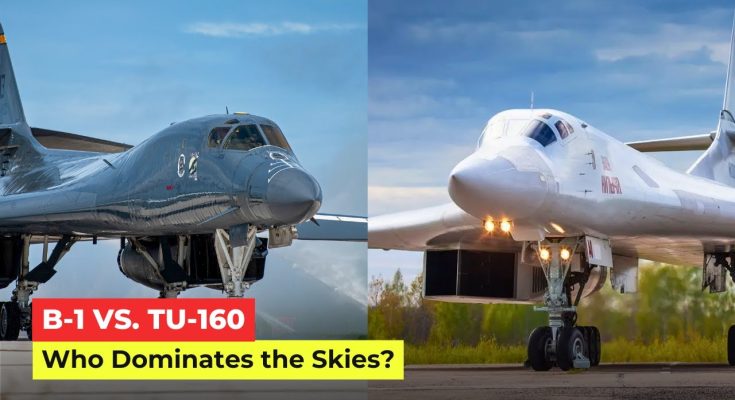In the realm of strategic bombers, two of the most powerful and iconic aircraft are the B-1 Lancer from the United States and the Tu-160 Blackjack from Russia. Both are engineered to carry out long-range, high-speed strikes and serve as potent deterrents in their respective nations’ arsenals. But what happens when these two giants meet in an aerial showdown? A battle between the B-1 Lancer and the Tu-160 is not just a contest of raw power, but a clash of stealth, speed, and strategic capabilities.
The B-1 Lancer: Stealth Meets Speed
The B-1 Lancer, often referred to as the “Bone”, was originally developed as a supersonic bomber but later modified to focus on low-level, high-speed penetration of enemy air defenses. One of its defining features is its variable-sweep wings, which can adjust for optimum performance at different speeds. At lower speeds, the wings sweep forward for better maneuverability, while at higher speeds, they extend backward to improve aerodynamics.
A key advantage of the B-1 Lancer is its stealth characteristics. Though not as stealthy as the newer B-2 Spirit, the B-1’s design incorporates radar-absorbing materials and a sleek profile that reduces its radar signature. This allows the Lancer to fly at low altitudes and speeds without being easily detected, making it highly effective in penetrating enemy airspace undetected. Its speed—capable of reaching Mach 1.25—also adds an element of surprise, as it can cover great distances quickly and strike at high speed.
The B-1 is also an impressive multi-role aircraft, capable of carrying a wide range of weapons, from conventional bombs to nuclear warheads. This flexibility makes it a formidable force in both tactical and strategic operations.
The Tu-160 Blackjack: The Sky Beast of Russia
In contrast, the Tu-160 Blackjack, known as the “White Swan” due to its graceful appearance, is a supersonic strategic bomber developed by the Soviet Union and later modernized by Russia. It is the largest and heaviest supersonic bomber in the world, capable of carrying an enormous payload of up to 40 tons of bombs or missiles. Its sleek design and supersonic capabilities—flying at speeds up to Mach 2.05—allow it to strike targets at long ranges with great speed.
The Tu-160’s long-range is one of its key features. It can travel over 7,500 kilometers without refueling, which allows it to project power globally without relying on forward bases. Like the B-1, the Tu-160 is capable of carrying nuclear and conventional payloads, including cruise missiles and gravity bombs. Additionally, its range and high speed make it a potent asset for launching quick strikes deep into enemy territory.
However, unlike the B-1, the Tu-160 does not emphasize stealth. While it has a relatively low radar signature compared to earlier bombers, it is not designed for stealth operations like the B-2 or the F-22. Instead, the Blackjack relies on its speed and maneuverability to evade interception, coupled with a robust electronic warfare suite to jam or confuse enemy radar.
Aerial Showdown: Stealth vs. Speed
In an aerial confrontation, the B-1 Lancer and Tu-160 Blackjack would bring their unique advantages to bear. The B-1’s stealth characteristics would give it an edge in penetrating heavily defended airspace undetected. Its ability to approach enemy territory at low altitudes and fly beneath radar coverage would allow it to launch surprise attacks with great precision.
On the other hand, the Tu-160’s speed and range make it an excellent tool for deep strike missions. While it lacks the B-1’s stealth, its sheer size and payload capacity give it a tactical advantage in terms of delivering massive firepower over long distances. If the battle comes down to a hit-and-run scenario, the Tu-160’s high speed might allow it to outrun the B-1 before the latter can engage.
However, countermeasures and electronic warfare will play a pivotal role in this showdown. The B-1’s sophisticated jamming systems could neutralize the Tu-160’s radar, giving it a momentary window to deliver a devastating strike. Conversely, the Tu-160’s speed and long-range missile capabilities would force the B-1 to engage at longer distances, reducing its ability to avoid incoming threats.
Conclusion: Who Wins?
In a direct, head-to-head aerial confrontation, the battle between the B-1 Lancer and the Tu-160 Blackjack would likely come down to the specific mission and environment. If the scenario favors stealth and surprise, the B-1 Lancer’s ability to penetrate enemy defenses undetected and launch a strike with precision could give it the upper hand. However, if speed and long-range missile attacks are the key, the Tu-160’s raw power and impressive payload might be more than enough to overwhelm its opponent.
Both aircraft represent the pinnacle of their respective nations’ bomber fleets and embody the strengths of their designs: the B-1’s combination of stealth and speed, and the Tu-160’s sheer power and range. In the end, their showdown would be an awe-inspiring display of aerial dominance and technological innovation, with each bomber playing a crucial role in the strategic balance of power.



